Smartphone Audio Testing - HTC One M8 and Samsung Galaxy S5
by Chris Heinonen on June 2, 2014 8:00 PM EST- Posted in
- Smartphones
- Mobile
- Testing
- Audio Precision
HTC One M8 Audio Testing
Looking at the numbers for the HTC One M8 there are a few things that stand out. The first is the output power of around 1.2 Vrms for all loads. This is a lot of power for a smartphone and should be able to drive almost any set of headphones you would use with it. There is more distortion on the 15 Ohm load but as there are 95 mW at max volume, you should be able to step the volume down a bit and reduce the THD+N.
We also see that crosstalk gets better as we have an easier load to drive. The lower (more negative) the crosstalk is, the less noise is leaking from one channel into the other. This is also the test most subject to error when using the USB automation of the phones. On the HTC One M8, USB testing results in a crosstalk level of -0.01 dB. If you are using your HTC One M8 for music you are best to not have it connected over USB while listening.
| 15 Ohm | 33 Ohm | 150 Ohm | 330 Ohm | |
| Dynamic Range | 91.791 dB | 92.074 dB | 91.690 dB | 92.008 dB |
| THD+N | 0.3365% | 0.0152% | 0.0103% | 0.0101% |
| Crosstalk (L) | -58.032 dB | -64.780 dB | -77.688 dB | -83.656 dB |
| Crosstalk (R) | -57.950 dB | -64.329 dB | -77.194 dB | -83.240 dB |
| Output Power | 95.55 mW | 47.63 mW | 11.14 mW | 5.116 mW |
| Output Voltage | 1.197 Vrms | 1.254 Vrms | 1.293 vRMS | 1.299 Vrms |
| Relative Level (20Hz - 20kHz) | ±0.664 dB | ±0.664 dB | ±0.665 dB | ±0.665 dB |
For some of the other results, I am going to pull in some charts that help to explain it better.
Relative level shows it is flat until the 20 kHz tone. Since most people can’t even hear this, the fall off there isn’t a large deal. The fall-off at 20Hz, which most earbuds cannot produce to a reasonable level, is much more slight and not audible. Unless you are playing back music for your puppy with the HTC One M8, this result is fine but it could be better.
THD+N is below 0.03% until just after 2 kHz when it begins a slow rise up past 0.2% at 20 kHz. This winds up being a good number but I am unsure what causes the rise in THD+N as the frequency increases.
The FFT spectrum for the 997 Hz test tone shows all artifacts below -80dB compared to the fundamental. The second and third harmonics are the largest, and those drop off by -10dB by the 4th and 5th.
This graph compares the frequency response to the BoomSound feature to having it disabled. As we saw earlier the regular frequency response is flat with a steep fall close to 20 kHz. Looking at BoomSound we see a steep roll-off below 30 Hz, a peak of almost +5dB around 60 Hz, a -5 dB section between 200 Hz and 500 Hz, and then a steep rise in the treble past 2 kHz.
Since I didn’t do the subjective listening, I would expect this to sound harsh in the treble, with the midrange being washed out by that dip in the middle. What we have is a high-end and a low-end that is +10 dB compared to the midrange. So these will sound twice as loud to you as the midrange. Using the interactive chart of music instruments by frequency you can find here, you can see what instruments this will obscure.
Comparing the THD+N ratio of BoomSound On to Off shows far more noise and distortion as well. If you want boomy bass, a harsh top-end, and no midrange, then use BoomSound. A better choice is to find headphones that suit your listening preferences more.
The HTC One M8 has good looking numbers, but putting them into better perspective requires more phone testing. As it is I see nothing that stands out as being a problem, unless you leave BoomSound on.


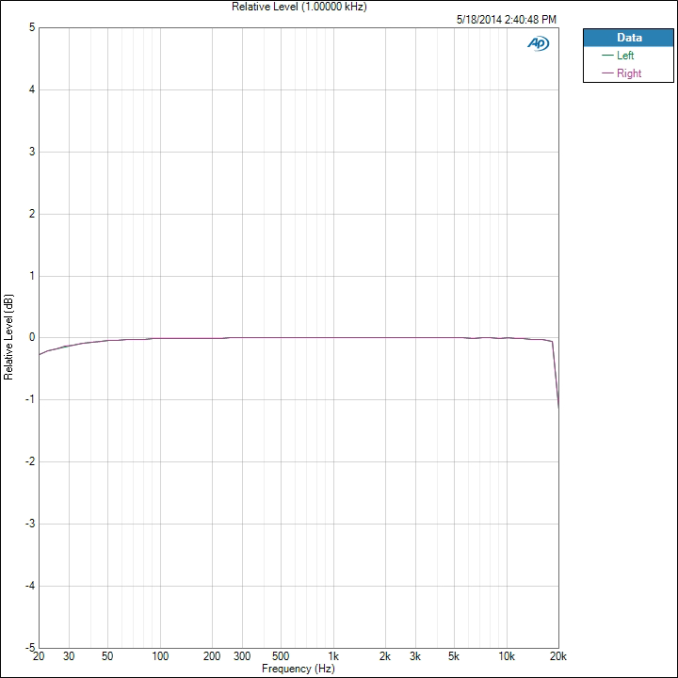
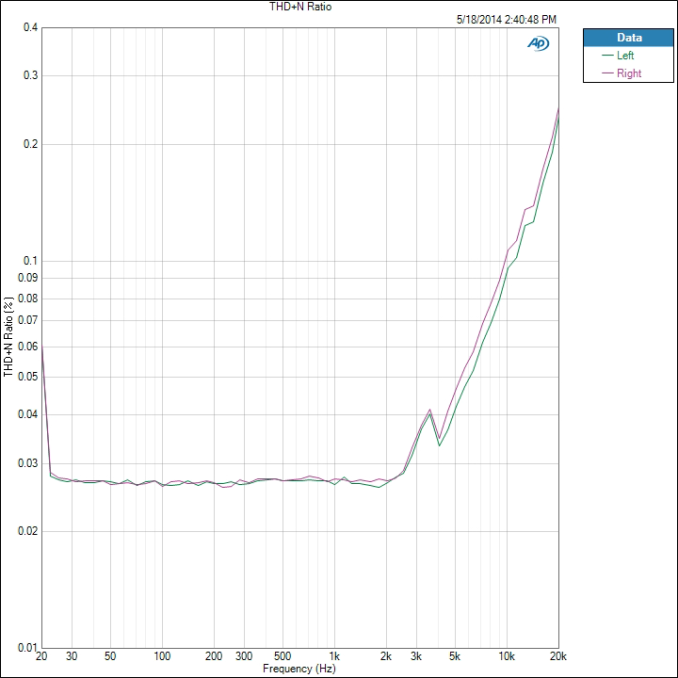
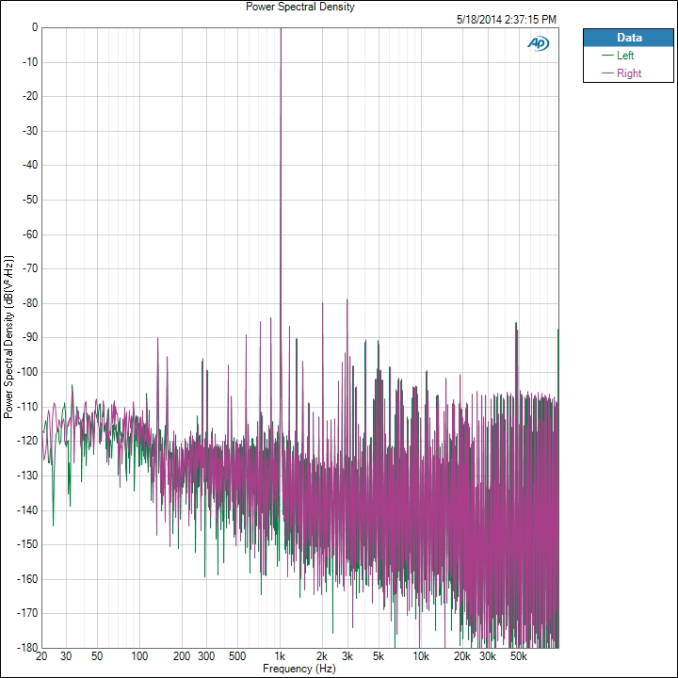
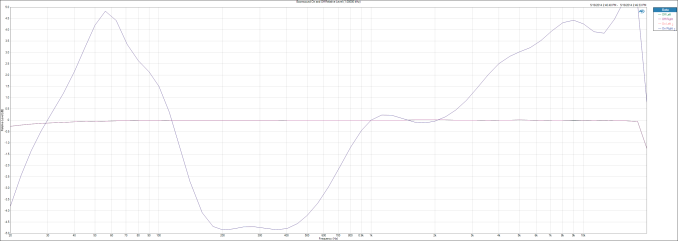
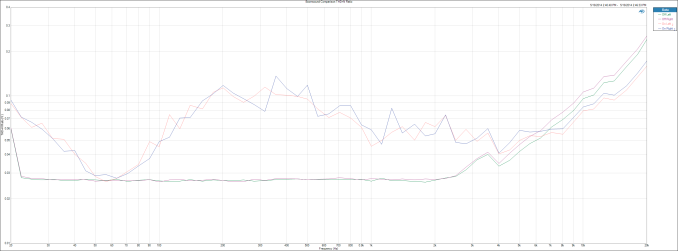








78 Comments
View All Comments
NeatOman - Monday, June 2, 2014 - link
Now I'm going to sit here waiting for the iPhone and Nexus 5/LG G2 audio test :)NeatOman - Monday, June 2, 2014 - link
Sorry!!!! I looked back and it seems to have been in the initial test (LG G2 and Nexus 5).cheinonen - Monday, June 2, 2014 - link
Since i updated this a bit I will retest my iPhone 5 soon.erikiksaz - Monday, June 2, 2014 - link
Any hopes of the Moto X being tested?Lazy_Geek - Wednesday, June 18, 2014 - link
gsmarena.com has some numbers for your interesttigmd99 - Monday, June 2, 2014 - link
Test iphone 5S please!!!bcg27 - Monday, June 2, 2014 - link
Really good to see some more results using the Audio Precision. Any chance of seeing some tests of independent amplifiers or D/A converters?cheinonen - Monday, June 2, 2014 - link
If the opportunity comes up then sure, but I don't know what the demand for that is. I'd be interested to see how well they compare to full on desktop DACs and Amps. I've been measuring a few of those recently.msackman - Tuesday, June 3, 2014 - link
I've just received a CEntrance HiFi-M8 and can easily drive it from my Sony Z1 Compact. I would love to see a comparison. Obviously one expects that dropping that much on a external DAC and headphone amp would make a massive improvement to these figures, but it would be worth seeing that measured, as much as possible.MadMan007 - Monday, June 2, 2014 - link
It's quite sad how bad the audio system in phones is, especially as they have largely replaced dedicated media players. I have no doubt that there have been lots of mp3 players or PMPs with much better audio systems over the years, so why can't phone manufacturers make something decent?